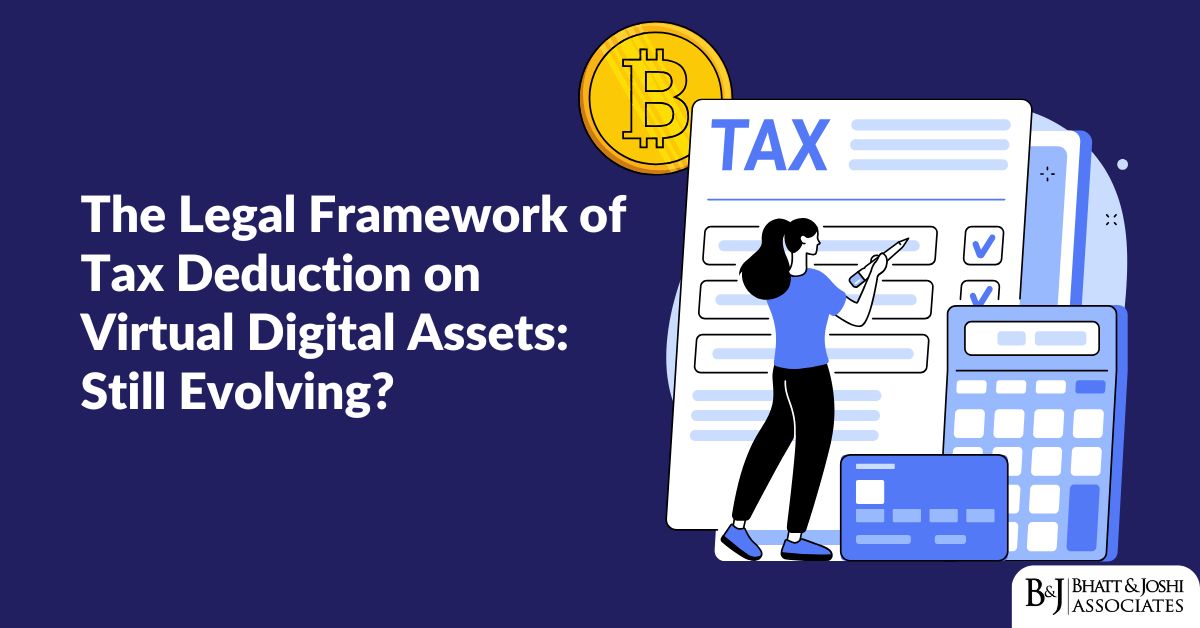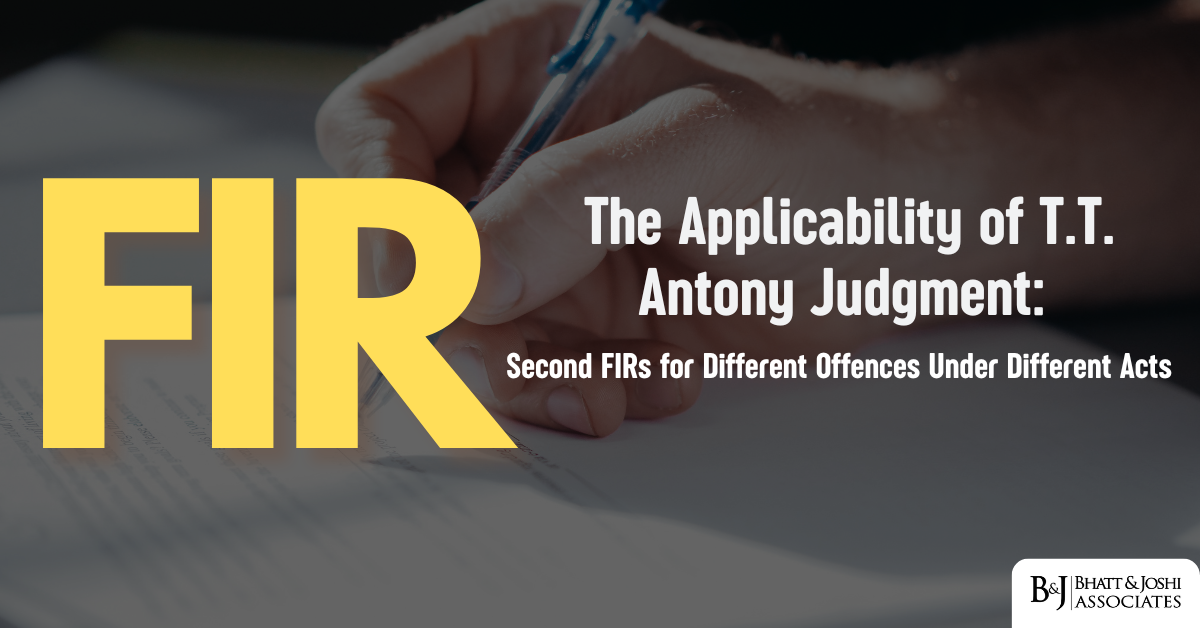Introduction
The emergence of Virtual Digital Assets (VDAs) represents one of the most significant developments in the global financial landscape over the past decade. These assets, encompassing cryptocurrencies, non-fungible tokens (NFTs), and other blockchain-based instruments, have disrupted traditional financial paradigms while creating unprecedented challenges for tax authorities worldwide. In India, the government has responded to this phenomenon with a distinct taxation framework, introduced through the Finance Act, 2022, which added specific provisions to the Income Tax Act, 1961 to address TDS on virtual digital assets.
This landmark legislative intervention marked India’s first explicit recognition of VDAs within the tax code, establishing a flat tax rate of 30% on income from VDA transfers and introducing Tax Deducted at Source (TDS) obligations through Section 194S. While these provisions have brought a measure of clarity to a previously ambiguous domain, they have also generated significant controversy and raised numerous questions regarding their scope, implementation, and economic impact.
This article examines the evolving legal framework for TDS on virtual digital assets in India, analyzing its statutory foundations, procedural requirements, compliance challenges, and judicial responses. The analysis extends beyond domestic considerations to include international perspectives and potential future trajectories for VDA taxation. Throughout, the article highlights the tension between regulatory objectives and market realities, questioning whether the current framework represents a stable endpoint or merely a transitional phase in the ongoing evolution of digital asset taxation.
Conceptual Framework and Legislative Background
Defining Virtual Digital Assets
The concept of Virtual Digital Assets finds its statutory definition in Section 2(47A) of the Income Tax Act, 1961, introduced by the Finance Act, 2022:
“‘virtual digital asset’ means— (a) any information or code or number or token (not being Indian currency or foreign currency), generated through cryptographic means or otherwise, by whatever name called, providing a digital representation of value exchanged with or without consideration, with the promise or representation of having inherent value, or functions as a store of value or a unit of account including its use in any financial transaction or investment, but not limited to investment scheme; and can be transferred, stored or traded electronically; (b) a non-fungible token or any other token of similar nature, by whatever name called; (c) any other digital asset, as the Central Government may, by notification in the Official Gazette specify;”
The definition further clarifies:
“‘non-fungible token’ means such digital asset as the Central Government may, by notification in the Official Gazette, specify;”
This expansive definition encompasses a wide range of digital assets, including cryptocurrencies like Bitcoin and Ethereum, utility tokens, security tokens, and NFTs. The breadth of the definition provides regulatory flexibility but also creates interpretive challenges for taxpayers and administrators alike.
Evolution of VDA Taxation in India
The taxation of VDAs in India has evolved through several distinct phases:
- Pre-Recognition Phase (Before 2018): No explicit recognition of VDAs in tax laws, leaving taxpayers and authorities to apply general principles of income taxation.
- Implicit Recognition Phase (2018-2022): While not explicitly addressed in the tax code, various official communications indicated that cryptocurrency gains would be taxable under existing provisions.
- Explicit Recognition Phase (2022 onwards): Introduction of specific provisions for VDA taxation through the Finance Act, 2022, including Section 115BBH (imposing a flat 30% tax on VDA transfer income) and Section 194S (mandating TDS on VDA transfers).
The Finance Minister’s Budget Speech of February 1, 2022, outlined the rationale for this approach:
“There has been a phenomenal increase in transactions in virtual digital assets. The magnitude and frequency of these transactions have made it imperative to provide for a specific tax regime. Accordingly, for the taxation of virtual digital assets, I propose to provide that any income from transfer of any virtual digital asset shall be taxed at the rate of 30 per cent.”
Legal Status of VDAs in India
It is crucial to distinguish between taxation and legalization. The introduction of tax provisions for VDAs does not confer legal tender status or regulatory approval on these assets. This position was clarified by the Finance Minister in her Budget Speech:
“I also propose to provide that no deduction in respect of any expenditure or allowance shall be allowed while computing such income except cost of acquisition. Further, loss from transfer of virtual digital asset cannot be set off against any other income. Gift of virtual digital asset is also proposed to be taxed in the hands of the recipient.”
The Reserve Bank of India (RBI) has maintained a cautious stance on VDAs, as evidenced by its circular dated April 6, 2018, which prohibited regulated entities from dealing in virtual currencies. While this circular was subsequently set aside by the Supreme Court in Internet and Mobile Association of India v. Reserve Bank of India (2020) 10 SCC 274, the RBI continues to express concerns about cryptocurrencies and has advocated for their prohibition.
Section 194S: TDS on Virtual Digital Assets Transfer
Statutory Provisions
Section 194S, introduced by the Finance Act, 2022, establishes the TDS framework for VDA transfers:
“(1) Any person responsible for paying to a resident any sum by way of consideration for transfer of a virtual digital asset, shall, at the time of credit of such sum to the account of the resident or at the time of payment of such sum by any mode, whichever is earlier, deduct an amount equal to one per cent of such sum as income-tax thereon:
Provided that in a case where the consideration for transfer of virtual digital asset is— (a) wholly in kind or in exchange of another virtual digital asset, where there is no part in cash; or (b) partly in cash and partly in kind but the part in cash is not sufficient to meet the liability of deduction of tax under this sub-section, the person responsible for paying such consideration shall, before releasing the consideration, ensure that tax has been paid in respect of such consideration for the transfer of virtual digital asset.”
The section further provides various thresholds and exceptions:
- No TDS requirement if the consideration does not exceed ₹10,000 in a financial year (₹50,000 for specified persons)
- Specific provisions for transactions through exchanges
- Special rules for payment through brokers and exchanges
Key Features and Requirements of Section 194S
- Applicable Rate: 1% of the consideration amount
- Point of Deduction: At the time of credit or payment, whichever is earlier
- Non-Cash Considerations: Special provisions for in-kind transfers or exchanges of VDAs
- Responsibility: The payer (buyer) is responsible for TDS compliance
- Threshold: Exemption for small transactions below specified thresholds
- Returns and Payments: Standard TDS return filing and payment requirements apply
The section presents several unique features compared to other TDS provisions:
- It applies to a novel and rapidly evolving asset class
- It addresses non-cash considerations explicitly
- It contemplates peer-to-peer transactions outside traditional financial intermediaries
CBDT Guidelines and Clarifications
The Central Board of Direct Taxes (CBDT) issued Circular No. 13 of 2022 dated June 22, 2022, providing clarifications on various aspects of Section 194S implementation:
- Exchange Responsibility: When transactions occur through exchanges, the responsibility for TDS compliance shifts to the exchange under specified conditions.
- Multiple Transactions: Guidelines for handling multiple small transactions that collectively exceed the threshold.
- Inter-Exchange Transactions: Clarification on TDS responsibilities when VDAs move between exchanges.
- VDA-to-VDA Exchanges: Procedure for TDS compliance in cases where one VDA is exchanged for another.
The circular specifically addressed the challenge of determining fair market value in VDA-to-VDA exchanges:
“In case of transfer of VDA for VDA, both the persons would be buyer as well as seller. Thus, both need to pay tax with respect to transfer of VDA and both need to deduct tax with respect to transfer of VDA. To remove this difficulty, it is clarified that in such case, the person responsible for paying such consideration shall be the person who is making payment, and is required to deduct tax in respect of such transfer.”
Implementation Challenges and Market Impact
Compliance Challenges
The implementation of Section 194S has presented several significant challenges:
- Valuation Issues: Determining the fair market value of VDAs, particularly for non-fungible tokens or less liquid cryptocurrencies, poses substantial challenges.
- Technology Integration: Integrating TDS compliance into blockchain-based systems requires sophisticated technological solutions.
- Cross-Border Transactions: Applying TDS provisions to transactions involving non-resident parties or occurring on foreign exchanges creates jurisdictional complexities.
- Identity Verification: The pseudonymous nature of many blockchain transactions complicates compliance with Know Your Customer (KYC) requirements for TDS.
In Coinbase Global, Inc. v. Commissioner of Income Tax (Writ Petition No. 8712 of 2022), the Delhi High Court acknowledged these challenges:
“The application of traditional tax compliance mechanisms to decentralized blockchain transactions presents novel challenges that require both technological solutions and legal adaptations. The Court recognizes the need for balanced approaches that fulfill regulatory objectives without imposing impracticable compliance burdens.”
Market Impact of TDS on Virtual Digital Assets
The introduction of TDS on virtual digital assets transfer has had significant impacts on the Indian cryptocurrency market:
- Trading Volume Reduction: Multiple cryptocurrency exchanges reported substantial declines in trading volumes following the implementation of Section 194S.
- Liquidity Challenges: The 1% TDS on each transaction has affected market liquidity, particularly for high-frequency traders.
- Offshore Migration: Some trading activity has reportedly migrated to offshore platforms beyond Indian tax jurisdiction.
- Compliance Costs: Exchanges and individual traders have incurred substantial costs to implement TDS compliance systems.
WazirX, one of India’s largest cryptocurrency exchanges, reported a 60-70% decline in daily trading volumes within ten days of the TDS implementation. Similarly, CoinDCX reported a significant shift in trading patterns, with a reduction in high-frequency trading and an increase in long-term investment positions.
Industry Response
The cryptocurrency industry has responded to the TDS requirements through various initiatives:
- Automated TDS Solutions: Development of integrated TDS calculation and deduction systems within exchange platforms.
- Industry Representations: Joint submissions to the Ministry of Finance seeking modifications to the TDS framework.
- Educational Campaigns: Efforts to educate users about their TDS obligations and compliance procedures.
- Technological Innovations: Implementation of technological solutions for TDS compliance in decentralized finance (DeFi) platforms.
The Blockchain and Crypto Assets Council (BACC), formerly part of the Internet and Mobile Association of India, has been particularly active in engaging with government authorities on these issues, advocating for a more balanced approach that maintains tax compliance while supporting industry growth.
Judicial Developments and Interpretative Issues
Key Court Decisions
While the judicial landscape regarding Section 194S remains nascent due to its recent introduction, several significant cases have addressed VDA taxation more broadly:
- Internet and Mobile Association of India v. Reserve Bank of India (2020) 10 SCC 274 The Supreme Court set aside the RBI’s circular prohibiting regulated entities from dealing in virtual currencies, stating:
“While we have recognized the power of RBI to take preemptive action, we are testing in this part of the order the proportionality of such measure, for the determination of which RBI needs to show at least some semblance of any damage suffered by its regulated entities. But there is none.”
While this case predated the VDA tax provisions, it established the principle that blanket prohibitions without adequate justification could be disproportionate. - Rashmi Nakshatra v. Union of India (Writ Petition No. 6496 of 2022, Delhi High Court) The petitioner challenged the constitutionality of Section 115BBH and Section 194S, arguing that:
a) The prohibition against offsetting losses from VDA transfers against other income was arbitrary b) The TDS rate of 1% created working capital issues for traders
The Court issued notice on the petition but declined to grant interim relief, observing:
“Tax policy falls within the domain of legislative competence, and courts exercise restraint in interfering with fiscal legislation unless there is manifest arbitrariness or violation of fundamental rights.” - Coinbase Global, Inc. v. Commissioner of Income Tax (Writ Petition No. 8712 of 2022, Delhi High Court) This case addressed the applicability of Section 194S to non-resident cryptocurrency exchanges. The Court issued interim directions for compliance while acknowledging the complex jurisdictional issues involved.
Interpretative Challenges
Several interpretative challenges have emerged regarding Section 194S:
- Scope of “Transfer”: Whether specific types of transactions (staking, lending, wrapping) constitute “transfers” for Section 194S purposes.
- Determination of Consideration: How to determine the “consideration” in complex DeFi transactions involving multiple parties and assets.
- Identification of Responsible Person: Establishing which party bears TDS responsibility in peer-to-peer transactions outside exchanges.
- Treatment of Non-Traditional VDAs: Applying the framework to emerging asset classes like synthetic tokens, wrapped tokens, or governance tokens.
In Nishant Joshi v. Union of India (Writ Petition No. 9759 of 2022, Delhi High Court), the petitioner sought clarification on whether mining rewards constitute “consideration” subject to TDS under Section 194S. The Court referred to CBDT guidelines and observed:
“The determination of whether mining rewards constitute ‘consideration’ requires examination of the specific mining process, consensus mechanism, and economic substance of the transaction. The mere receipt of newly minted tokens may not automatically trigger TDS obligations in the absence of an identifiable payer or transfer event.”
Addressing Procedural Ambiguities
The implementation of Section 194S has raised several procedural questions addressed through administrative guidance:
- CBDT Circular No. 13 of 2022: Clarified responsibilities of exchanges and brokers, methodology for multiple transactions, and approach to cross-platform transfers.
- CBDT Notification No. 67/2022: Specified the forms and procedures for TDS returns related to VDA transactions.
- CBDT Notification No. 73/2022: Exempted certain categories of persons from Section 194S obligations under specified conditions.
These administrative interventions have helped address immediate operational issues but have also highlighted the challenges of applying traditional TDS frameworks to blockchain-based transactions.
Comparative International Approaches
United States Approach
The United States has adopted a significantly different approach to cryptocurrency taxation:
- Asset Classification: The Internal Revenue Service (IRS) treats virtual currencies as property rather than currency for tax purposes.
- Tax Treatment: Capital gains tax applies to cryptocurrency disposals, with rates depending on holding period (short-term vs. long-term).
- Information Reporting: Form 1099-B reporting for cryptocurrency exchanges, but no equivalent to India’s TDS system.
- Enforcement Strategy: Focused on information reporting and audit mechanisms rather than preemptive withholding.
In the landmark case Jarrett v. United States (Civil Action No. 3:21-cv-00419, M.D. Tenn. 2022), the court addressed the taxation of staking rewards, with implications for the broader treatment of crypto-asset acquisition:
“The creation of new property, whether through mining, staking, or other consensus mechanisms, does not necessarily constitute a taxable event until the taxpayer exercises dominion and control over the property and has the practical ability to dispose of it.”
European Union Approaches
The European Union has demonstrated a diversity of approaches among member states:
- Germany: Exempts cryptocurrency gains from taxation if held for more than one year, with no withholding mechanism.
- France: Applies a flat 30% tax on cryptocurrency gains, with simplified declaration procedures.
- Portugal: Has historically exempted cryptocurrency gains from taxation for individual investors, though recent proposals suggest potential changes.
The European Court of Justice in Skatteverket v. David Hedqvist (Case C-264/14) addressed the VAT treatment of cryptocurrency exchanges:
“The exchange of traditional currencies for units of the ‘bitcoin’ virtual currency and vice versa… are transactions exempt from VAT. Bitcoin with bidirectional flow can be considered a means of payment, and the exemptions provided for in the VAT Directive should apply.”
Asian Jurisdictions
Other major Asian economies have implemented varied approaches:
- Singapore: Treats cryptocurrency gains as capital in nature (generally not taxable) if held as investment, with no withholding requirements.
- Japan: Classifies cryptocurrency gains as “miscellaneous income” taxed at progressive rates up to 55%, without a withholding mechanism.
- South Korea: Applies a 20% tax on cryptocurrency gains above a threshold, with implementation delayed until 2025.
These comparative approaches highlight that India’s TDS mechanism represents one of the most administratively intensive approaches globally, reflecting India’s broader reliance on withholding mechanisms within its tax system.
Practical Compliance Strategies for VDA Transactions
For Individual Traders
Individual VDA traders can adopt several strategies to navigate the TDS framework effectively:
- Record-Keeping Systems: Maintaining comprehensive transaction records, including acquisition costs, transfer details, and TDS deducted.
- TDS Credit Reconciliation: Regular reconciliation between Form 26AS, Annual Information Statement (AIS), and personal transaction records.
- Exchange Selection: Considering the TDS compliance capabilities of different exchanges when choosing trading platforms.
- Tax Planning: Structuring trading activities to optimize for the TDS impact while maintaining compliance.
- Advance Tax Management: Adjusting advance tax payments to account for the impact of non-creditable TDS in the case of losses.
For Cryptocurrency Exchanges
Exchanges operating in India have implemented various compliance mechanisms:
- Automated TDS Systems: Integration of TDS calculation, deduction, and reporting within trading platforms.
- User Education: Providing clear guidance to users regarding TDS implications of their transactions.
- Compliance Documentation: Developing comprehensive documentation of compliance procedures to demonstrate good faith efforts.
- API-Based Solutions: Implementing API-based solutions for real-time TDS processing and reporting.
- Cross-Border Compliance: Developing frameworks for addressing TDS obligations in cross-border transactions.
For DeFi Platforms
Decentralized Finance (DeFi) platforms face unique challenges in implementing TDS compliance:
- Smart Contract Modifications: Some platforms have modified smart contracts to incorporate TDS functionality.
- Off-Chain Compliance Solutions: Implementation of off-chain systems to track on-chain activities for compliance purposes.
- Legal Entity Structures: Establishment of legal entities to interface between DeFi protocols and regulatory requirements.
- Geofencing Strategies: Implementation of geographic restrictions to manage regulatory exposure.
- Compliance Partnerships: Collaboration with specialized compliance service providers for TDS management.
Evolving Regulatory Landscape
Cryptocurrency Regulation Bill
The broader regulatory environment for VDAs in India continues to evolve. The government has indicated plans to introduce comprehensive legislation governing cryptocurrencies and other digital assets. The proposed legislation is expected to:
- Define Regulatory Categories: Establish clear categories for different types of VDAs with distinct regulatory treatments.
- Assign Regulatory Authority: Designate specific regulatory bodies for VDA oversight.
- Establish Operating Parameters: Define permissible activities and operational requirements for VDA service providers.
- Enhance Consumer Protection: Implement safeguards for retail investors in the VDA space.
In a written reply in the Lok Sabha on July 25, 2022, the Finance Minister stated:
“The Government has been examining various issues related to cryptocurrencies including their potential implications on the financial stability of the country, and has been taking proactive steps through broad-based consultations and awareness campaigns for investors.”
RBI’s Digital Rupee
The introduction of the Central Bank Digital Currency (CBDC) or “Digital Rupee” by the Reserve Bank of India represents another significant development in the digital asset landscape. The RBI launched the wholesale segment pilot of the Digital Rupee on November 1, 2022, followed by the retail segment pilot on December 1, 2022.
The relationship between the Digital Rupee and private VDAs has tax implications:
- The Digital Rupee is explicitly excluded from the definition of VDAs under Section 2(47A).
- Transactions involving the Digital Rupee will follow traditional currency taxation principles rather than VDA-specific provisions.
- The introduction of the Digital Rupee may influence future regulatory approaches to private VDAs.
The RBI has emphasized the distinction between the Digital Rupee and cryptocurrencies, with the Deputy Governor stating in a speech on November 3, 2022:
“The fundamental difference between CBDC and cryptocurrencies is that while CBDC is a digital form of currency issued by the central bank, cryptocurrencies are not ‘currency’ in the traditional sense of the term.”
International Regulatory Convergence
India’s approach to VDA taxation exists within a global context of evolving regulatory frameworks:
- FATF Guidelines: The Financial Action Task Force has issued guidance on a risk-based approach to virtual assets, influencing regulatory approaches worldwide.
- G20 Discussions: The G20, under India’s presidency in 2023, has included cryptocurrency regulation on its agenda, potentially leading to greater international coordination.
- OECD Framework: The Organization for Economic Cooperation and Development has developed a Crypto-Asset Reporting Framework (CARF) for automatic exchange of information.
India’s participation in these international forums suggests potential future alignment with global standards, which could influence the evolution of domestic VDA taxation.
Critical Analysis and Future Directions for TDS on Virtual Digital Assets
Economic Efficiency Considerations
The current TDS framework for VDAs raises several economic efficiency concerns:
- Liquidity Impact: The 1% TDS on each transaction affects market liquidity and may increase bid-ask spreads.
- High-Frequency Trading: The TDS structure disproportionately impacts high-frequency trading strategies, potentially reducing market efficiency.
- Working Capital Blockage: TDS results in temporary capital blockage until tax credit can be claimed, creating opportunity costs.
- Competitive Position: The TDS requirement may disadvantage Indian VDA platforms compared to international alternatives.
In ZebPay v. Union of India (Writ Petition No. 8712 of 2022, Mumbai High Court), industry representatives argued:
“The 1% TDS on each transaction creates a cascading effect for frequent traders, effectively resulting in capital outflows disproportionate to actual tax liability, thereby distorting market efficiency and competitiveness.”
Constitutional and Legal Questions for TDS on Virtual Digital Assets
Several constitutional and legal questions surround the VDA tax framework:
- Article 14 Challenges: Whether the prohibition on offsetting VDA losses against other income violates the equality provisions of Article 14 of the Constitution.
- Proportionality Concerns: Whether the TDS mechanism imposes a disproportionate compliance burden relative to the tax collection objective.
- Legislative Competence: The appropriate classification of VDAs within the constitutional division of legislative powers.
- International Tax Treaty Implications: How the VDA-specific provisions interact with India’s network of tax treaties.
The Delhi High Court in Rashmi Nakshatra v. Union of India acknowledged these concerns while noting the legislature’s broad discretion in tax policy:
“While the Court recognizes the petitioner’s concerns regarding the distinctive treatment of virtual digital assets under the tax code, the legislature enjoys wide latitude in creating reasonable classifications for taxation purposes, particularly in emerging technological domains where policy considerations may justify specialized approaches.”
Potential Reform Directions for TDS on Virtual Digital Assets
Several potential reforms could address current challenges in the VDA taxation framework:
- Tiered TDS Rates: Implementing variable TDS rates based on transaction volume or trader categories to reduce impact on high-frequency trading.
- Loss Offset Provisions: Allowing limited offset of VDA losses against VDA gains beyond a single financial year.
- Enhanced Reporting Alternative: Replacing or supplementing TDS with enhanced reporting requirements similar to international approaches.
- Safe Harbor Provisions: Establishing safe harbors for certain categories of VDA transactions to reduce compliance burdens for low-risk activities.
- Automated TDS Credits: Implementing automatic TDS credit systems to reduce working capital impact.
Industry associations have advocated for these reforms in various submissions to the Ministry of Finance. The Blockchain and Crypto Assets Council proposed in its pre-budget memorandum for 2023-24:
“A more calibrated approach to VDA taxation would balance revenue objectives with the need to foster innovation and formalization in the emerging digital asset ecosystem. Specific reforms to consider include tiered TDS rates, expanded loss offset provisions, and streamlined compliance mechanisms.”
Technological Solutions and Innovations
Technological innovations may help address some of the current challenges:
- Blockchain-Native TDS: Implementation of TDS functionality directly within blockchain protocols through smart contracts.
- Decentralized Identifier Integration: Leveraging decentralized identity systems to facilitate compliance while preserving privacy.
- API Standardization: Developing standardized APIs for TDS reporting across different platforms and exchanges.
- Automated Compliance Tools: Creating specialized tools for individual traders to track and manage TDS obligations.
- Regulatory Technology (RegTech) Solutions: Implementing advanced data analytics for compliance monitoring and enforcement.
Conclusion
The legal framework for TDS on virtual digital assets in India represents a significant regulatory innovation, marking the country’s first comprehensive attempt to integrate these novel assets into the established tax system. The introduction of Section 194S, with its unique approach to TDS on virtual digital assets transfer, reflects both the government’s recognition of the growing significance of digital assets and its commitment to ensuring tax compliance in this emerging domain.
However, the analysis reveals that this framework remains very much in an evolutionary state. The statutory provisions, while establishing clear principles, have required substantial administrative clarification through circulars and notifications. The implementation challenges highlight the tension between traditional tax administration mechanisms and the decentralized, borderless nature of blockchain-based assets. The market impact of the TDS requirements demonstrates the delicate balance between regulatory objectives and economic efficiency.
The comparative international perspective underscores India’s distinctive approach, particularly in its reliance on withholding mechanisms rather than reporting requirements. This distinctive approach reflects India’s broader tax administration strategy but creates unique challenges in the context of digital assets that operate globally and instantaneously.
The judicial developments, though still limited given the recent introduction of these provisions, indicate that courts are grappling with the application of constitutional principles to this novel domain. The recognition of both regulatory concerns and innovation imperatives suggests a nuanced judicial approach that may help shape future regulatory evolution.
Looking ahead, the framework for VDA taxation is likely to continue evolving in response to market developments, technological innovations, and emerging international standards. The potential introduction of comprehensive cryptocurrency legislation, the development of the Digital Rupee, and India’s participation in global regulatory discussions all point toward further refinement of the current approach.
For stakeholders in the VDA ecosystem—individual traders, exchanges, DeFi platforms, and institutional investors—this evolving landscape requires adaptive compliance strategies that can respond to regulatory changes while maintaining operational viability. For policymakers, the challenge lies in crafting a framework that achieves legitimate regulatory objectives without stifling innovation or driving activity into unregulated channels.
In addressing the question posed in the title—”The Legal Framework of TDS on virtual digital assets: Still Evolving?”—the analysis provides a clear affirmative answer. The current framework represents not an endpoint but a significant waypoint in an ongoing regulatory journey. As VDA technologies, markets, and international standards continue to develop, India’s approach to taxing these assets will inevitably evolve as well, hopefully toward a balanced framework that supports both regulatory objectives and sustainable innovation in this transformative domain.














